Hand-Made Embroidered Electromyography: Towards a Solution for Low-Income Countries
Abstract
:1. Introduction
2. Materials and Methods
2.1. Electrode Embroidery Training
2.1.1. Workshop 1: Embroidery with Assistance
2.1.2. Workshop 2: Embroidery without Assistance
2.1.3. Data Analysis
2.2. Functional Evaluation of Electrodes
2.2.1. Materials
2.2.2. Protocol
2.2.3. Signal Post-Processing
2.2.4. Data Analysis
3. Results
3.1. Electrode Fabrication Training
3.2. Self-Reported Electrical Tests
3.3. Hand- and Machine-Sewn Electrode Electrical Tests
3.4. Electrode Functional Tests
4. Discussion
Supplementary Materials
Author Contributions
Funding
Acknowledgments
Conflicts of Interest
References
- Hogrel, J.Y. Clinical Applications of Surface Electromyography in Neuromuscular Disorders. Clin. Neurophysiol. 2005, 35, 59–71. [Google Scholar] [CrossRef] [PubMed]
- Klein, C.S.; Li, S.; Hu, X.; Li, X. Editorial: Electromyography (EMG) Techniques for the Assessment and Rehabilitation of Motor Impairment Following Stroke. Front. Neurol. 2018, 9, 1122. [Google Scholar] [CrossRef] [PubMed]
- Liu, Y.; Tian, L.; Raj, M.S.; Cotton, M.; Ma, Y.; Ma, S.; McGrane, B.; Pendharkar, A.V.; Dahaleh, N.; Olson, L.; et al. Intraoperative monitoring of neuromuscular function with soft, skin-mounted wireless devices. NPJ Digit. Med. 2018, 1, 19. [Google Scholar] [CrossRef] [PubMed] [Green Version]
- Amuna, P.; Zotor, F.B. Epidemiological and nutrition transition in developing countries: Impact on human health and development: The epidemiological and nutrition transition in developing countries: Evolving trends and their impact in public health and human development. Proc. Nutr. Soc. 2008, 67, 82–90. [Google Scholar] [CrossRef] [PubMed] [Green Version]
- Moran, A.; Forouzanfar, M.; Sampson, U.; Chugh, S.; Feigin, V.; Mensah, G. The epidemiology of cardiovascular diseases in sub-Saharan Africa: The global burden of diseases, injuries and risk factors 2010 study. Prog. Cardiovasc. Dis. 2013, 56, 234–239. [Google Scholar] [CrossRef] [PubMed] [Green Version]
- Donkor, E.S. Stroke in the Century: A Snapshot of the Burden, Epidemiology, and Quality of Life. Stroke Res. Treat. 2018, 2018, 1–10. [Google Scholar] [CrossRef] [PubMed] [Green Version]
- Ashrafuzzaman, M.; Hossain, M.S.A.; Joaa, A.M.; Aziz, M.T. Development of Low Cost Central Monitoring Platform by Modeling and Simulation for Patients Care in Low Middle Income Countries. In Proceedings of the World Congress on Medical Physics and Biomedical Engineering, Prague, Czech Republic, 3–8 June 2018; pp. 737–744. [Google Scholar]
- Suzuki, R.; Okazaki, S.; Kuniya, M.; Muraoka, Y. Low-Cost 2-Channel Electromyography Telemeter using a Personal Computer Microphone Port. Int. Phys. Med. Rehabil. 2017, 5, 2. [Google Scholar] [CrossRef] [Green Version]
- International Labour Organisation. India Wage Report. 2018. Available online: https://www.ilo.org/wcmsp5/groups/public/---asia/---ro-bangkok/---sro-new_delhi/documents/publication/wcms_638305.pdf (accessed on 10 March 2020).
- Pylatiuk, C.; Muller-Riederer, M.; Kargov, A.; Schulz, S.; Schill, O.; Reischl, M.; Bretthauer, G. Comparison of Surface Monitoring Electrodes for Long Term Use in Rehabilitation Device Control. In Proceedings of the IEEE International Conference on Rehabilitation Robotics, Kyoto, Japan, 23–26 June 2009. [Google Scholar]
- Pitou, S.; Wu, F.; Shafti, S.; Michael, B.; Stopforth, R.; Howard, M. Embroidered Electrodes for Control of Affordable Myoelectric Prostheses. In Proceedings of the IEEE International Conference on Robotics and Automation (ICRA), Brisbane, Australia, 21–25 May 2018. [Google Scholar]
- Shafti, A.; Manero, R.R.; Borg, A.; Althoefer, K.; Howard, M. Embroidered Electromyography: A Systematic Design Guide. IEEE Trans. Neural Sys. Rehab. Eng. 2016, 25, 1472–1480. [Google Scholar] [CrossRef] [PubMed] [Green Version]
- Tokarska, M.; Frydrysiak, M.; Zięba, J. Electrical properties of flat textile material as inhomegeneous and anisotropic structure. Mater. Sci. Mater. Electron. 2013, 24, 5061–5068. [Google Scholar] [CrossRef] [Green Version]
- Tokarska, M. Characterization of electro-conductive textile materials by its biaxial anisotropy coefficient and resistivity. Mater. Sci. Mater. Electron. 2019, 30, 4093–4103. [Google Scholar] [CrossRef] [Green Version]
- International Labour Organisation. Wages and Working Hours in the Textiles, Clothing, Leather and Footwear Industries. 2014. Available online: https://www.ilo.org/wcmsp5/groups/public/---ed_dialogue/---sector/documents/publication/wcms_300463.pdf (accessed on 10 March 2020).
- Gámez, A.; Hernandez-Morante, J.J.; Gil, J.; Esparza, F.; Martínez, C. The effect of surface electromyography biofeedback on the activity of extensor and dorsiflexor muscles in elderly adults: A randomized trial. Nature 2019, 9, 1–9. [Google Scholar] [CrossRef] [PubMed]
- Rodger, C.; Railton, R.; Walsh, A.; Donald, H. Cost of ECG electrodes. Br. Med. J. 1977, 1, 1351. [Google Scholar] [CrossRef] [PubMed]
- Shafti, A.; Manero, R.B.R.; Borg, A.M.; Althoefer, K.; Howard, M.J. Designing embroidered electrodes for wearable surface electromyography. In Proceedings of the IEEE International Conference on Robotics and Automation (ICRA), Stockholm, Sweden, 16–21 May 2016; pp. 172–177. [Google Scholar]
- Rogers, J.L.; Howard, K.I.; Vessey, J.T. Using Significance Tests to Evaluate Equivalence Between Two Experimental Groups. Phys. Bull. 1993, 113, 553–565. [Google Scholar] [CrossRef] [PubMed]
- Claudon, L. Relevance of the EMG/Grip Relationship in Isometric Anisotonic Conditions. Int. Occup. Saf. Ergon. 2003, 9, 121–134. [Google Scholar] [CrossRef] [PubMed] [Green Version]
- Mendell, L.M. The size principle: A rule describing the recruitment of motoneurons. Neurophysiol. 2005, 93, 3024–3026. [Google Scholar] [CrossRef] [PubMed] [Green Version]
- Reaz, M.B.I.; Hussain, M.; Mohd-Yasin, F. Techniques of EMG signal analysis: Detection, processing, classification and applications. Biol. Proc. Online 2006, 8, 11. [Google Scholar] [CrossRef] [PubMed] [Green Version]
- Hoozemans, M.J.; van Dieën, J.H. Prediction of handgrip forces using surface EMG of forearm muscles. Electromyogr. Kinesiol. 2005, 15, 358–366. [Google Scholar] [CrossRef] [PubMed]
- ASTM International. ASTM D4496-13, Standard Test Method for D-C Resistance or Conductance of Moderately Conductive Materials; ASTM International: West Conshohocken, PA, USA, 2013. [Google Scholar]
- Beckmann, L.; Neuhaus, C.; Medrano, G.; Jungbecker, N.; Walter, M.; Gries, T.; Leonhardt, S. Characterization of textile electrodes and conductors using standardized measurement setups. Phys. Meas. 2010, 31, 233. [Google Scholar] [CrossRef] [PubMed]
- Manero, R.R.; Shafti, A.; Michael, B.; Grewal, J.; Fernández, J.L.R.; Althoefer, K.; Howard, M.J. Wearable embroidered muscle activity sensing device for the human upper leg. In Proceedings of the 38th Annual International Conference of the IEEE Engineering in Medicine and Biology Society (EMBC), Orlando, FL, USA, 16–20 August 2016. [Google Scholar]
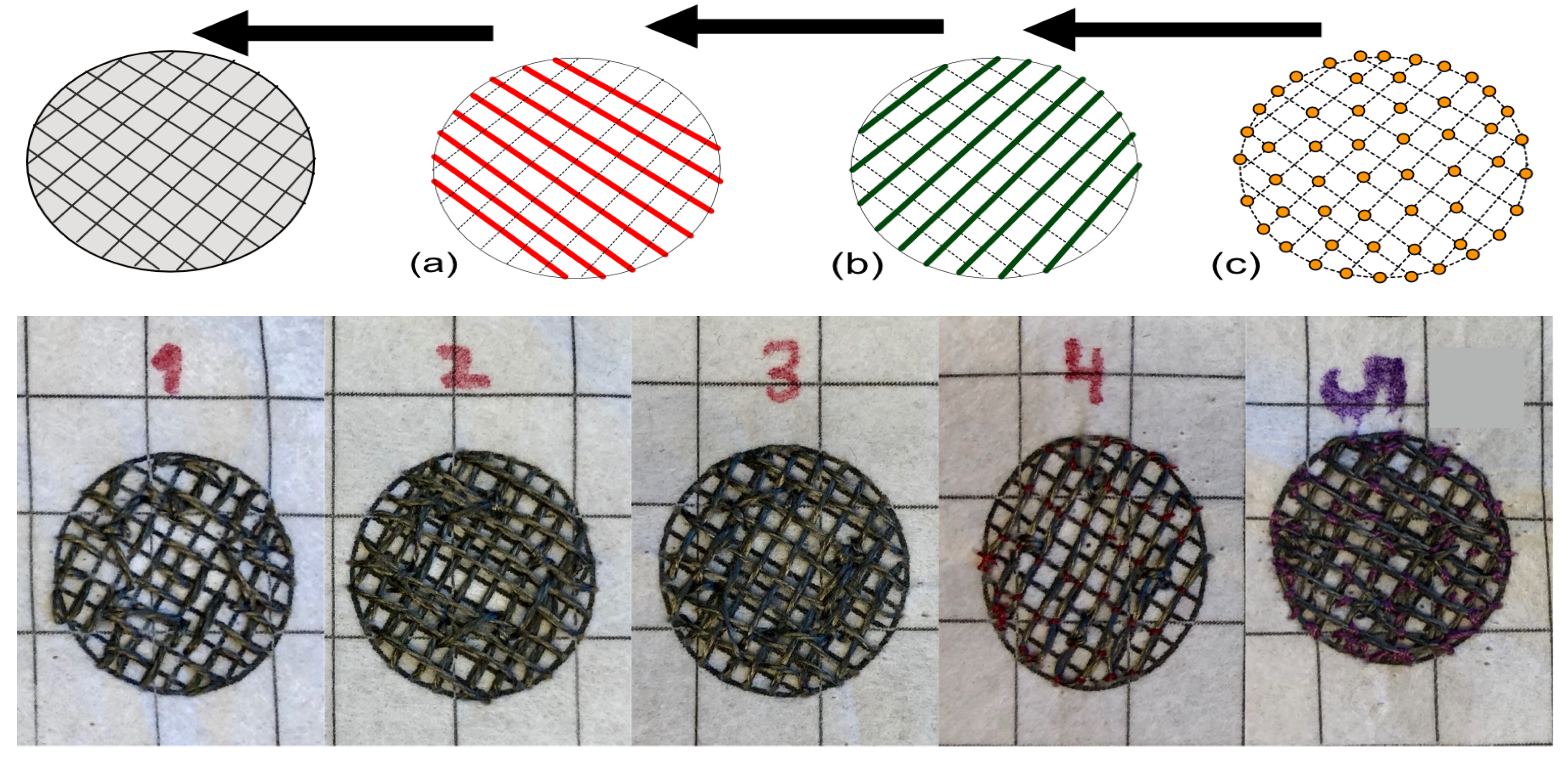


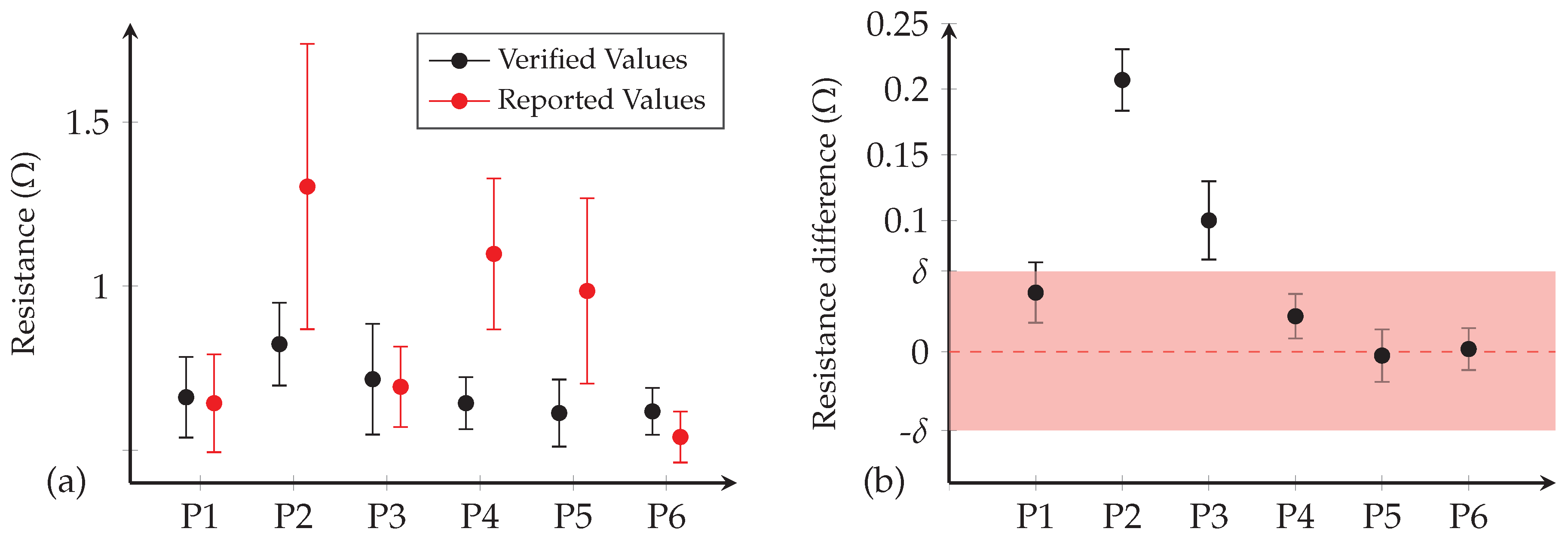

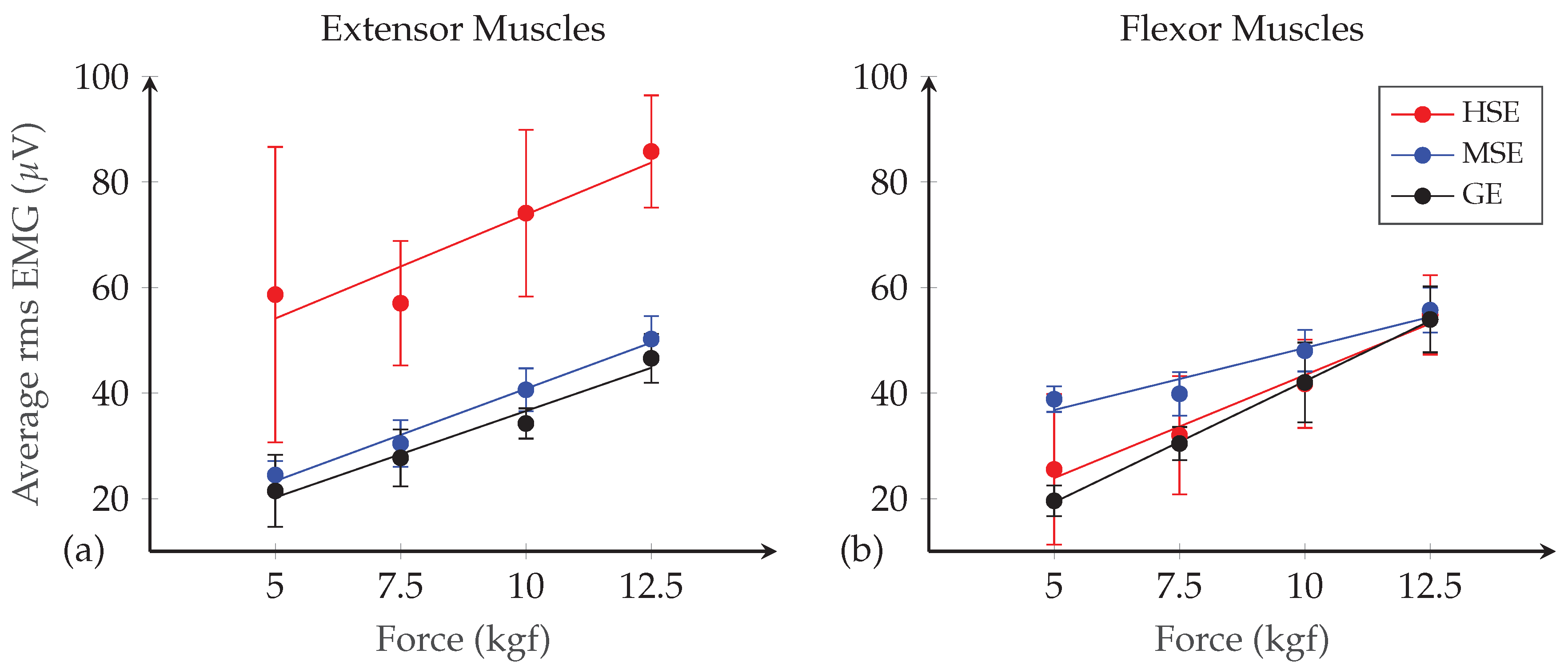
 | 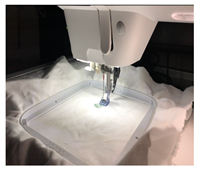 | 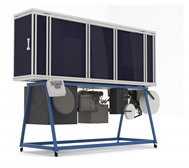 |
|---|---|---|
| Hand-sewn electrodes production | Machine-sewn electrode production | Gel electrodes production |
| Raw material cost: | [17] | |
| Equipment cost: | ||
| Labour cost: /day | /day | /day |
| Electrode cost: (labour) | (labour) | |
| Consumable cost: | ||
| Note: Dry and reusable, easy production in rural area, potential to involve the unskilled population and create employment. | Dry and reusable, good signal quality, electricity reliant production, plant and machine operator required. | Disposable and adhesive electrode, good signal quality, electricity reliant production, plant and machine operator required. |
| Participant | P1 | P2 | P3 | P4 | P5 | P6 | Baseline |
|---|---|---|---|---|---|---|---|
| Mean | 0.66 | 0.82 | 0.71 | 0.64 | 0.61 | 0.61 | 0.64 |
| SD | 0.123 | 0.126 | 0.168 | 0.079 | 0.102 | 0.071 | 0.042 |
| Type | Extensor Muscle | Flexor Muscle | ||||
|---|---|---|---|---|---|---|
| Gradient | r | Gradient | r | |||
| HSE | 268 | 98 | ||||
| MSE | 207 | 138 | ||||
| GE | 43 | 26 | ||||
© 2020 by the authors. Licensee MDPI, Basel, Switzerland. This article is an open access article distributed under the terms and conditions of the Creative Commons Attribution (CC BY) license (http://creativecommons.org/licenses/by/4.0/).
Share and Cite
Pitou, S.; Michael, B.; Thompson, K.; Howard, M. Hand-Made Embroidered Electromyography: Towards a Solution for Low-Income Countries. Sensors 2020, 20, 3347. https://doi.org/10.3390/s20123347
Pitou S, Michael B, Thompson K, Howard M. Hand-Made Embroidered Electromyography: Towards a Solution for Low-Income Countries. Sensors. 2020; 20(12):3347. https://doi.org/10.3390/s20123347
Chicago/Turabian StylePitou, Samuel, Brendan Michael, Karina Thompson, and Matthew Howard. 2020. "Hand-Made Embroidered Electromyography: Towards a Solution for Low-Income Countries" Sensors 20, no. 12: 3347. https://doi.org/10.3390/s20123347





